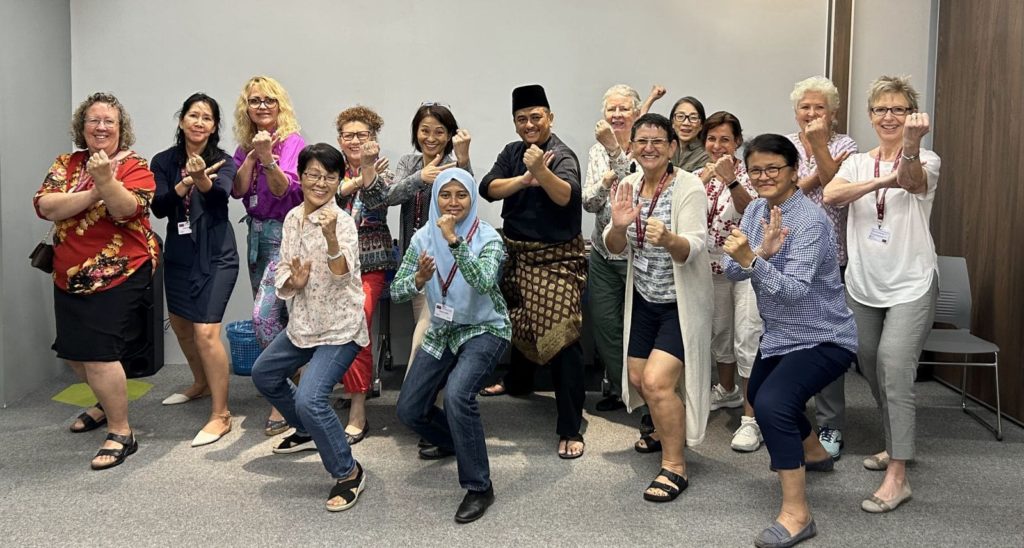
Our speaker, silat exponent, Mohd. Nazrin Wahab, told us that Silat Melayu is sometimes known as ‘a coward’s martial art’, but I think it is ‘a thinking man’s martial art.’ He explained that the ultimate goal of silat is to survive, not crush or destroy an opponent, which justifies the ‘hit and run’ approach. Hit the attacker quickly or momentarily disable him or distract him to the point where you can disengage and then run. There are so many variables that a silat practitioner must keep in mind all at once at the crucial moment; his breathing – in or out? where is his weight centred? where is an escape route? is the opponent advancing or retreating? from which direction should you attack him? is he armed or not? where is he most vulnerable? and so on. Assessments have to be made on each of these issues in a split second and a plan of ‘attack’ formed instantly. That’s why I would say it is a thinking man’s martial art.
Silat is a Malay self-defence art, long ago used in the military to defend borders, especially when your weapon, such as a sling shot or a bow, is lost and you have to depend on yourself. It can be used against up to four combatants at a time, but not more. The version that Encik Mohd. Nazrin Wahab specializes in is the Bugis type with aspects from Pahang and Kedah. Silat has been practiced since the 16th century with different names in different islands all over the archipelago, for instance muy thai in the north. In the past many strategies were kept secret.
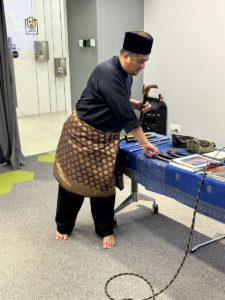
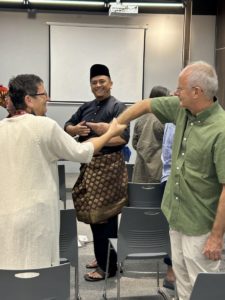
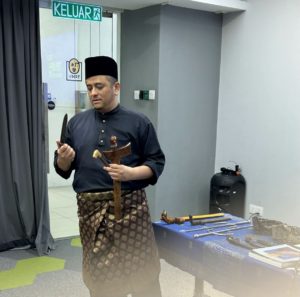
He pointed out characteristics that are common to silat. The movements are circular and natural. It utilizes the full range of human motion, with the focus on ligaments, which are trained to stretch and strengthen, unlike other forms of martial art which focus on strengthening muscles. Actions are soft but strong, hard but pliant. Points of contact are referred to as betina (feminine or ventral) which tend to be sensitive such as the under arm as opposed to janta (male or dorsal) the upper, exposed side of the arm. Lightning speed is one of the essentials. Trickery and illusions are relied upon to win. Moves like punching and kicking must come from a strong core which incorporates breathing techniques. One must look before turning. Frequently in some martial arts it is harder vs. harder which results in breakage, but silat follows a belief in stronger vs. softer. In karate an exponent does not move, but in silat a fighter will often step aside, moving off the line of attack.
In combat, there are four things the brain cannot ignore and these are used to advantage in silat: faces, stories (used to distract), use of questions (especially silly ones, also to distract) and open body language. In his mind the silat fighter must always have a +1, a tactic held in reserve to use when necessary, for instance only attacking when exhaling for more power.
In order to learn silat, one must first ask for permission to study under a master (Ijazah). Before undergoing initiation, the master must accept the learner and then the teacher/learner relationship becomes like a father/son relationship. One must undergo tests (Ujian) before learning advanced level techniques. Just to survive one must have resilience. Traditionally one learned for 100 days, for eight hours a day in order to reach the instructor or master level (Tamat). At that point one can have their own master class. In Malaysia, there are seven prominent styles of silat with over 550 groups.
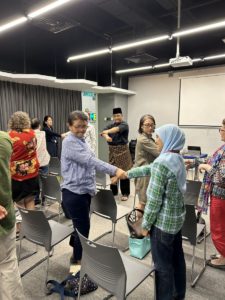

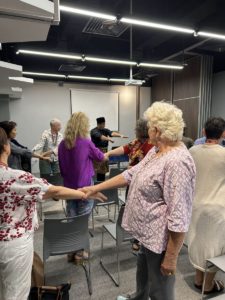
Instruction in the use of weapons, such as the keris and other weapons is also included. Most Malay weapons are designed around the hand and the human body. Although he told us that the hardest weapons are actually our elbows and our knees, for instance an elbow to the temple can be very effective. People will strike out with their fists but that frequently results in injured hands. More effective is to use hands to push away the opponent, as striking may have the same effect as stabbing.
Sometimes he told us he realizes he has been sitting at his computer for too long and he needs a break. So instead of going for a cup of coffee or a snack, he indulges in a routine of silat moves to refresh himself. He demonstrated for us what he would do. It was an absolutely intimidating release of coiled energy, sudden strong movements, turns, twists, striking out with his arms, slapping his upper arms, jumping, slapping his feet on the floor on landing, even his shirt material made a swishing sound, all accompanied by incredibly heavy breathing. Breathless when he finished, he begged us for a moment to recover while we finally exhaled. And to think he did all that in the fasting month. I’m glad he was on our side.
It was an instructive morning with Mohd. Nazrin Wahab and it seemed there was more he could have told us. We learned so much about this mystical, historical form of self-defence, even trying some of the breathing techniques ourselves. So where do you fall on the issue – a coward’s martial art or a thinking man’s martial art?
Review: Leslie Muri
Lecture & Demonstration: 5th April, 2023
